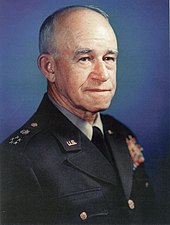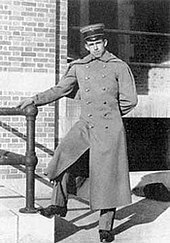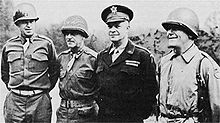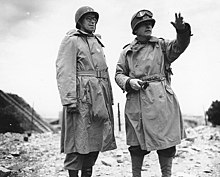Omar N. Bradley
Omar Nelson Bradley (born February 12, 1893 in Clark , Missouri , † April 8, 1981 in New York City ) was an American General of the Army and one of the leading commanders of the US armed forces in World War II in North Africa and Europe.
Life
Before the First World War
Bradley grew up as the son of a teacher in humble circumstances in Randolph County , Missouri , near his birthplace Clark . He attended local schools and initially wanted to try enrolling at the University of Missouri in Columbia . However, we were advised there with him Military Academy in West Point to try. Bradley took first place on the aptitude tests in his area and began his studies in 1911. He graduated in 1915 in a class that produced 59 future generals, including Dwight D. Eisenhower . Military historians call them “ the class the stars fell on ” (German: “the year on which the stars fell”), alluding to the star as the generals' badge of rank .
First World War
Bradley was transferred to the US 14th Infantry Regiment, but like many of his comrades, he was not used in Europe in the First World War . Instead, he received a number of assignments at home. So he was used in 1915 First Lieutenant ( Oberleutnant ) on the Mexican border . When the USA entered the war in 1917, he was promoted to captain and took up a post in Montana . In August 1918 Bradley was transferred to the 19th Infantry Division , which was to advance to Europe. The influenza - pandemic ( Spanish flu ) and the cease-fire , however, meant that he did not leave the United States.
Interwar period
Bradley taught and studied between the world wars. From 1920 to 1924 he taught mathematics at West Point . It was 1924 Major promoted and took for advanced infantry course at Fort Benning ( Georgia part). After a brief period of service in Hawaii , he studied from 1928 to 1929 at the Command and General Staff College at Fort Leavenworth . From 1929 he taught again at West Point, only interrupted in 1934 by studying at Army War College . He was promoted to Lieutenant Colonel in 1936 and served in the War Department from 1938 .
Second World War
In February 1941, Bradley was promoted to Brigadier General and given command at Fort Benning. In February 1942 he took command of the 82nd Infantry Division and switched to the 28th Infantry Division in June .
Bradley received his first front line command in early 1943 after Operation Torch . He was to be given command of the US VIII Corps . Instead he was sent to North Africa to serve under Eisenhower and Patton . Bradley was Commanding General of the II. US Corps in April 1943 and led it in the decisive battles in April and May, in which 40,000 German soldiers were captured shortly before Bizerta and the Tunisia campaign was ended shortly afterwards . He was promoted to lieutenant general in June 1943 .
Bradley's II Corps landed in Sicily in July 1943 as part of Patton's 7th Army during Operation Husky . Due to a personal derailment of Patton during this campaign (unauthorized attack on Palermo), not this but Bradley was later selected as commander of the American troops in the attack on Normandy . The command for the whole operation was with Dwight D. Eisenhower.
During Operation Overlord in early June 1944, he led the 1st US Army , which was deployed on the beaches codenamed Utah and Omaha . In the following years, the army took Cherbourg, among others . In July, Bradley planned Operation Cobra , a US attempt to escape from the Normandy bridgehead, which was largely successful. On July 26th, he achieved the decisive breakthrough at Saint-Lô , which allowed the troops of the 3rd US Army and other Allied troops to enclose almost two German armies in the so-called Falaise pocket. At the beginning of August Bradley took over the command of the 12th US Army Group in northern France, which with 21 divisions and a total of 900,000 soldiers was the largest group of troops ever commanded by a US general.
The Allied military leadership did not initially plan to conquer Paris . However, after civilian and Resistance uprisings in the city, the Allies were moved to intervene. Eisenhower instructed Bradley to invade the city, for which he put the 4th Infantry Division and the French 2nd Panzer Division ( Battle of Paris ). Paris capitulated on August 26th.
The armies of the 12th Army Group reached the Siegfried Line in September . Contrary to Bradley's suggestion, Eisenhower decided at this point to lead the next Allied offensive to the north of the front, Operation Market Garden , which ended with an Allied defeat and the loss of over 16,000 soldiers. After defending against the German Ardennes offensive in December 1944 / January 1945, Bradley's armies were able to cross the Rhine in March after conquering the Ludendorff Bridge between Remagen and Erpel and reached the Elbe in April. In March 1945 he became a four-star general . At the time of the German surrender , Bradley's Army Group comprised four American armies with a total of 1.3 million soldiers.
post war period
Bradley was the head of the United States Department of Veterans Affairs two years after the end of World War II . He is credited with investing heavily in improving the department's health system and helping veterans fill their educational gaps (see G.I. Bill of Rights ). He was appointed Chief of Staff of the Army in 1948 and one year later the official first chairman of the Joint Chiefs of Staff.
On September 22, 1950 Bradley was promoted to General of the Army , the highest rank in the US Army , making him the fifth and so far last officer to receive this rank. In this role he was instrumental in the conflict between Truman and MacArthur . In particular, his testimony before the Senate , in which he pointed to the devastating effects of MacArthur's demands on the strategic position of the US in Western Europe, caused a major shift in sentiment in the US.
In 1950 Bradley was appointed chairman of the NATO committee. He remained on this committee until August 1953 when he left active military service to take up some positions in the private sector. One of these positions was chairing the board of directors of Bulova Watch Company from 1958 to 1973 .
In 1951 he published his memoirs under the title A Soldier's Story, and he contradicted the 1945 claim by British Field Marshal Bernard Montgomery that he had won the Battle of the Bulge . In 1966 he married Esther Dora Buhler. Almost four years later he participated as a military advisor in the creation of Franklin J. Schaffner's Oscar- winning film Patton - Rebel in Uniform (1970), in which he is played by Karl Malden .
One of his last public activities was in January 1981 when Ronald Reagan was inaugurated . Bradley spent the last years of his life in a specialty residence at the William Beaumont Army Medical Center in Texas .
Bradley died in 1981. His funeral took place on April 14th in Arlington National Cemetery . Bradley was a Freemason and was promoted to Master at West Point Lodge # 877, Highland Falls , New York , in 1923 .
honors and awards
Honors
- A museum and library in his hometown of Moberly in Randolph County , Missouri got his name.
- The armored personnel carriers M2 Bradley and M3 Bradley were named after him.
- One of a series of US postage stamps issued in 2000 bears his portrait.
- He is ranked 22nd in the historical ranking of the highest officers in the United States .
Awards
Selection of awards, sorted based on the Order of Precedence of the Military Awards:
-
 Defense Distinguished Service Medal
Defense Distinguished Service Medal
-
 Army Distinguished Service Medal (4 ×)
Army Distinguished Service Medal (4 ×) -
 Navy Distinguished Service Medal
Navy Distinguished Service Medal
-
 Silver Star
Silver Star
-
 Legion of Merit
Legion of Merit
-
 Bronze star
Bronze star
-
 Presidential Medal of Freedom
Presidential Medal of Freedom
-
 Order of the Bath
Order of the Bath
-
 Commander's Cross of the Order of the Rebirth of Poland
Commander's Cross of the Order of the Rebirth of Poland
-
 Croix de guerre with a bronze palm
Croix de guerre with a bronze palm
-
 War Cross of Luxembourg
War Cross of Luxembourg
-
 Kutuzov 1st class
Kutuzov 1st class
-
 Suworoworden 1st class
Suworoworden 1st class
Fonts
- Omar N. Bradley: A Soldier's Story. ISBN 0-375-75421-0
- Omar N. Bradley, Clay Blair : A General's Life. To Autobiography. 1983.
literature
- Steven L. Ossad: Omar Nelson Bradley: America's GI General 1893-1981 . Columbia: University of Missouri Press, 2017, ISBN 978-0-8262-2136-0 .
Web links
- Literature by and about Omar N. Bradley in the catalog of the German National Library
- Newspaper article about Omar N. Bradley in the 20th century press kit of the ZBW - Leibniz Information Center for Economics .
- Biography on the Arlington National Cemetery website
- Biography of the US Army Center for Military History
- Biography on acusd.edu (English)
| personal data | |
|---|---|
| SURNAME | Bradley, Omar N. |
| ALTERNATIVE NAMES | Bradley, Omar Nelson (full name) |
| BRIEF DESCRIPTION | American general |
| DATE OF BIRTH | February 12, 1893 |
| PLACE OF BIRTH | Clark , Missouri |
| DATE OF DEATH | April 8, 1981 |
| Place of death | New York City |



